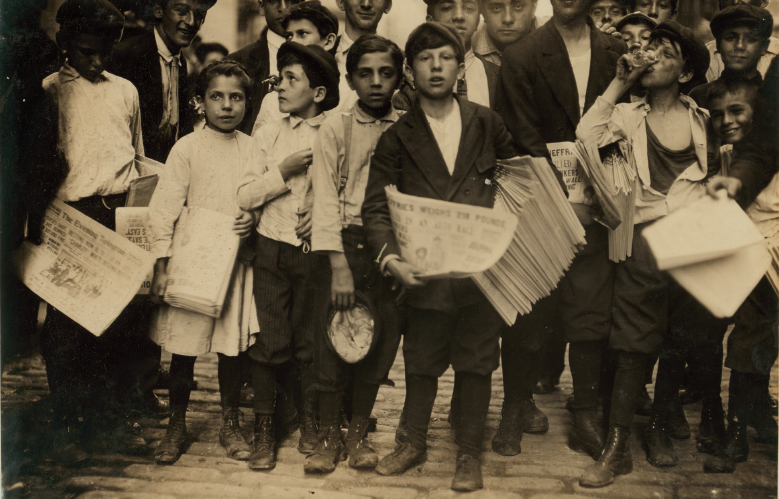The Penny Press Era: Newspapers Become Mass Media
By the late 1820s, the average newspaper cost six cents a copy and was sold through yearly subscriptions priced at ten to twelve dollars. Because that price was more than a week’s salary for most skilled workers, newspaper readers were mostly affluent. By the 1830s, however, the Industrial Revolution made possible the replacement of expensive handmade paper with cheaper machine-made paper. During this time, the rise of the middle class spurred the growth of literacy, setting the stage for a more popular and inclusive press. In addition, breakthroughs in technology, particularly steam-powered presses replacing mechanical presses, permitted publishers to produce as many as four thousand newspapers an hour, which lowered the cost of newspapers. Penny papers soon began competing with six-cent papers. Though subscriptions remained the preferred sales tool of many penny papers, they began relying increasingly on daily street sales of individual copies.

Day and the New York Sun
In 1833, printer Benjamin Day founded the New York Sun with no subscriptions and the price set at one penny. The Sun—whose slogan was “It shines for all”—highlighted local events, scandals, police reports, and serialized stories. Like today’s supermarket tabloids, the Sun fabricated stories, including the infamous moon hoax, which reported “scientific” evidence of life on the moon. Within six months, the Sun’s lower price had generated a circulation of eight thousand, twice that of its nearest New York competitor.
The Sun’s success initiated a wave of penny papers that favored human-interest stories: news accounts that focus on the daily trials and triumphs of the human condition, often featuring ordinary individuals facing extraordinary challenges. These kinds of stories reveal journalism’s ties to literary traditions, such as the archetypal conflicts between good and evil, normal and deviant, or between individuals and institutions. Today, this can be found in everyday feature stories that chronicle the lives of remarkable people or in crime news that details the daily work of police and the misadventures of criminals. As in the nineteenth century, crime stories remain popular and widely read.
Bennett and the New York Morning Herald
The penny press era also featured James Gordon Bennett’s New York Morning Herald, founded in 1835. Bennett, considered the first U.S. press baron, freed his newspaper from political influence. He established an independent paper serving middle-and working-class readers as well as his own business ambitions. The Herald carried political essays and news about scandals, business stories, a letters section, fashion notes, moral reflections, religious news, society gossip, colloquial tales and jokes, sports stories, and, later, reports from the Civil War. In addition, Bennett’s paper sponsored balloon races, financed safaris, and overplayed crime stories. Charles Dickens, after returning to Britain from his first visit to America in the early 1840s, used the Herald as a model for the sleazy Rowdy Journal, the fictional newspaper in his novel Martin Chuzzlewit. By 1860, the Herald reached nearly eighty thousand readers, making it the world’s largest daily paper at the time.
Changing Economics and the Founding of the Associated Press
The penny papers were innovative. For example, they were the first to assign reporters to cover crime, and readers enthusiastically embraced the reporting of local news and crime. By gradually separating daily front-page reporting from overt political viewpoints on an editorial page, penny papers shifted their economic base from political parties to the market—to advertising revenue, classified ads, and street sales. Although many partisan papers had taken a moral stand against advertising some controversial products and “services”—such as medical “miracle” cures, abortionists, and especially the slave trade—the penny press became more neutral toward advertisers and printed virtually any ad. In fact, many penny papers regarded advertising as consumer news. The rise in ad revenues and circulation accelerated the growth of the newspaper industry. In 1830, 650 weekly and 65 daily papers operated in the United States, reaching a circulation of 80,000. By 1840, a total of 1,140 weeklies and 140 dailies attracted more than 300,000 readers.
In 1848, six New York newspapers formed a cooperative arrangement and founded the Associated Press (AP), the first major news wire service. Wire services began as commercial organizations that relayed news stories and information around the country and the world using telegraph lines and, later, radio waves and digital transmissions. In the case of the AP, the New York papers provided access to both their own stories and those from other newspapers. In the 1850s, papers started sending reporters to cover Washington, D.C.; and in the early 1860s more than a hundred reporters from northern papers went south to cover the Civil War, relaying their reports back to their home papers via telegraph and wire services. The news wire companies enabled news to travel rapidly from coast to coast and set the stage for modern journalism.
The marketing of news as a product and the use of modern technology to dramatically cut costs gradually elevated newspapers from an entrepreneurial stage to the status of a mass medium. By adapting news content, penny papers captured the middle-and working-class readers who could now afford the paper and also had more leisure time to read it. As newspapers sought to sustain their mass appeal, news and “factual” reports about crimes and other items of human interest eventually superseded the importance of partisan articles about politics and commerce.